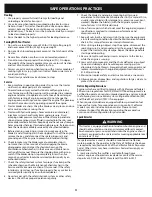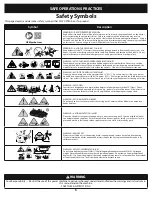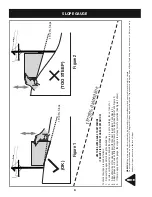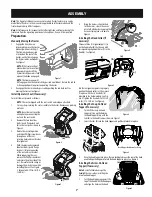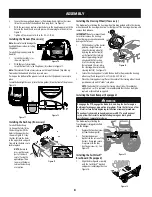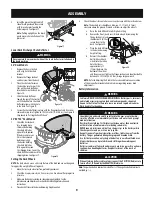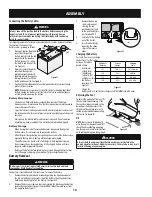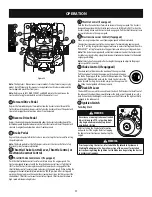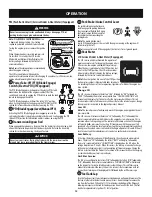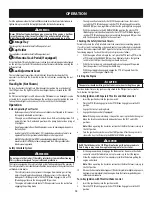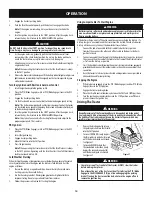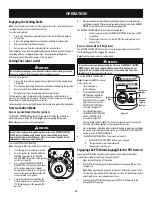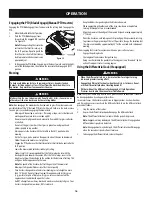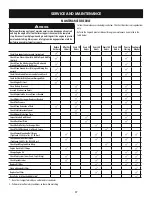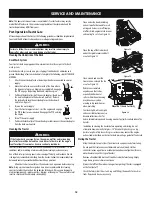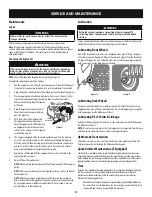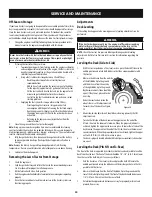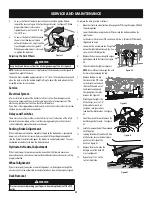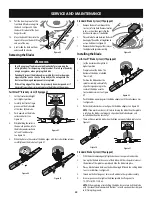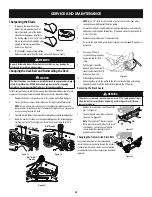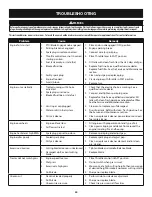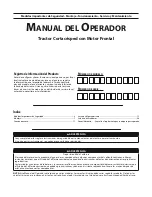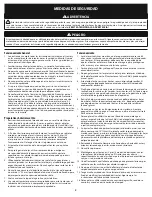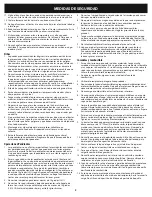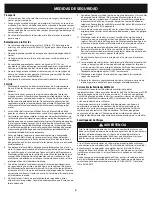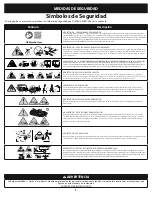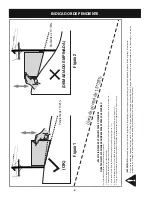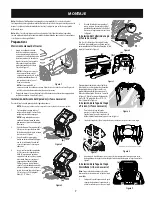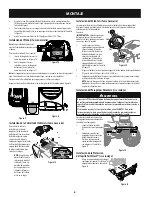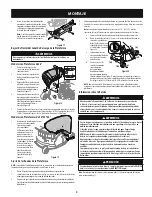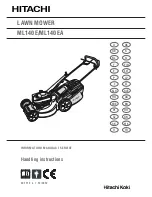
18
SERVICE AND MAINTENANCE
Note:
This operator's manual covers several models. Tractor features may vary by
model. Not all features in this manual are applicable to all tractor models and the
tractor depicted may differ from yours.
Post-Operation Tractor Care
After each operation of the tractor, the following procedures should be implemented
to extend the life of your tractor and ensure safe operating conditions.
WARNING
Failure to follow these recommendations may result in serious injury to
yourself or others and may cause damage to the tractor.
Cleaning the Underside of the Deck
Deck Wash System
Your tractor’s deck is equipped with a water port on its surface as part of its deck
wash system.
Use the deck wash system to rinse grass clippings from the deck’s underside and
prevent the buildup of corrosive chemicals. Complete the following steps AFTER EACH
MOWING:
1.
Attach the nozzle adapter to a standard garden hose connected to a water
supply.
2.
Move the tractor to an area within reach of the hose where
the dispersal of wet grass clippings is acceptable. Disengage
the PTO, engage the parking brake and stop the engine.
3.
Pull back the lock collar (a) of the nozzle adapter (b) and push
the nozzle adapter onto the deck wash nozzle (c). Release
the lock collar to lock the nozzle adapter on the deck wash
nozzle. See Figure 31.
4.
Turn on the water supply.
5.
From the tractor operator’s seat, start the engine and engage
the PTO. Allow to run as needed. Disengage the PTO and stop
the engine.
6.
Turn off the water supply.
7.
Pull back the lock collar of the nozzle adapter to disconnect the nozzle adapter
from the deck wash nozzle.
Cleaning the Tractor
WARNING
If the tractor has been recently run, the engine, muffler and surrounding
metal surfaces will be hot and can cause burns to the skin. Let the engine
cool for at least five minutes. Exercise caution to avoid burns.
Your tractor should be cleaned after each use and under certain conditions, i.e. dry
conditions and/or mulching situations, additional cleaning may be necessary.
One of the best ways to keep your tractor running efficiently and to reduce fire risk
is to regularly remove debris buildup from the tractor. Follow the recommendations
below and contact your authorized dealer with any questions.
•
Allow the tractor to cool at least five minutes in an open area before cleaning.
Note:
Using a pressure washer or garden hose is not recommended for cleaning
your tractor other than to clean the underside of the deck. It may cause damage to
electrical components, spindles, pulleys, bearings or the engine. The use of water will
result in shortened life and reduce serviceability.
a
b
c
Figure 31
•
Clean under the hood, including
exhaust manifold, around fuses, all
wiring and harnesses, muffler pipe,
muffler shield, engine intake screens
and cooling fins, etc. See Figure 32.
•
Clean the top of the tractor deck,
under the spindle covers and belt
area. See Figure 33.
•
Clean around and near the
transmission, axle and the fan
area. See Figure 34.
•
Debris can accumulate
anywhere on the tractor,
especially on horizontal
surfaces. Additional cleaning
may be necessary when
mowing in dry conditions or
when mulching.
•
Fuel leaks/spills, oil leaks/spills
and excess lubrication can also
become collections sites for
debris. Immediate repair and cleaning up oil or fuel spills can help reduce fire
hazards.
•
In addition to cleaning the tractor before operating and storing, do not
attempt to mow unusually tall grass, 10” (25cm) or higher, dry grass (e.g.,
pasture) or piles of dry leaves. Dry grass or leaves may contact the engine
exhaust and/or build up on the tractor deck presenting a potential fire hazard.
Storing the Tractor
•
Allow the tractor to cool at least five minutes in an open area before storing.
•
Do not park the tractor near any flammable materials (wood, cloth or
chemicals) or any open flames or other potential source of ignition (furnace,
water heater or any other type of heater).
•
Remove all combustible materials from the tractor before storing. Empty
cargo boxes, grass catchers or containers.
•
Always shut off fuel flow when storing or transporting if tractor is equipped
with a fuel shutoff.
•
Check the fuel system (lines, tank, cap and fittings) frequently for cracks or
leaks. Repair and clean as necessary.
Figure 32
Figure 33
Wheel Not Shown For Clarity
Figure 34

